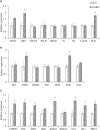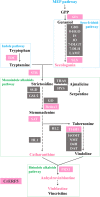CrERF5, an AP2/ERF Transcription Factor, Positively Regulates the Biosynthesis of Bisindole Alkaloids and Their Precursors in Catharanthus roseus
- PMID: 31379908
- PMCID: PMC6657538
- DOI: 10.3389/fpls.2019.00931
CrERF5, an AP2/ERF Transcription Factor, Positively Regulates the Biosynthesis of Bisindole Alkaloids and Their Precursors in Catharanthus roseus
Abstract
Catharanthus roseus contains a variety of monoterpenoid indole alkaloids (MIAs), among which bisindole alkaloids vinblastine and vincristine are well-known to have antitumor effects and widely used in clinical treatment. However, their contents in C. roseus is extremely low and difficult to meet market demands. Therefore, it is of great significance to study the transcriptional regulation mechanism of MIAs biosynthesis for high yielding of bisindole alkaloids in C. roseus. Studies have shown that MIAs biosynthesis in C. roseus has complex temporal and spacial specificity and is under tight transcriptional regulation, especially bisindole alkaloids. In this study, an AP2/ERF transcription factor CrERF5 was selected by RNA-seq of C. roseus organs, and its full-length sequence was cloned and characterized. CrERF5 responds to both ethylene and JA signals and is localized in the nucleus. CrERF5 could activate the transcriptional activity of the TDC promoter. Transient overexpressing CrERF5 in C. roseus petals caused a significant increase of the expression levels of key genes in both the upstream and downstream pathways of MIAs biosynthesis while silencing CrERF5 resulted in a decrease of them. Accordingly, the contents of bisindole alkaloids anhydrovinblastine and vinblastine, monoindole alkaloids ajmalicine, vindoline, and catharanthine were strongly enhanced in CrERF5-overexpressing petals while their contents decreased in CrERF5-silenced plants. These results suggested that CrERF5 is a novel positive ethylene-JA-inducible AP2/ERF transcription factor upregulating the MIAs biosynthetic pathway leading to the bisindole alkaloids accumulation.
Keywords: AP2/ERF transcription factor; Catharanthus roseus; MIAs biosynthesis; bisindole alkaloids; transcriptional regulation.
Figures








Similar articles
-
Establishment of recombinant Catharanthus roseus stem cells stably overexpressing ORCA4 for terpenoid indole alkaloids biosynthesis.Plant Physiol Biochem. 2023 Mar;196:783-792. doi: 10.1016/j.plaphy.2023.02.039. Epub 2023 Feb 23. Plant Physiol Biochem. 2023. PMID: 36848864
-
A Novel AP2/ERF Transcription Factor CR1 Regulates the Accumulation of Vindoline and Serpentine in Catharanthus roseus.Front Plant Sci. 2017 Dec 6;8:2082. doi: 10.3389/fpls.2017.02082. eCollection 2017. Front Plant Sci. 2017. PMID: 29270185 Free PMC article.
-
Terpene Moiety Enhancement by Overexpression of Geranyl(geranyl) Diphosphate Synthase and Geraniol Synthase Elevates Monomeric and Dimeric Monoterpene Indole Alkaloids in Transgenic Catharanthus roseus.Front Plant Sci. 2018 Jul 6;9:942. doi: 10.3389/fpls.2018.00942. eCollection 2018. Front Plant Sci. 2018. PMID: 30034406 Free PMC article.
-
[Advance in biosynthesis of terpenoid indole alkaloids and its regulation in Catharanthus roseus].Zhongguo Zhong Yao Za Zhi. 2016 Nov;41(22):4129-4137. doi: 10.4268/cjcmm20162208. Zhongguo Zhong Yao Za Zhi. 2016. PMID: 28933078 Review. Chinese.
-
Catharanthus roseus (L.) G. Don: A review of its ethnobotany, phytochemistry, ethnopharmacology and toxicities.J Ethnopharmacol. 2022 Feb 10;284:114647. doi: 10.1016/j.jep.2021.114647. Epub 2021 Sep 22. J Ethnopharmacol. 2022. PMID: 34562562 Review.
Cited by
-
Overexpression of the Apple (Malus × domestica) MdERF100 in Arabidopsis Increases Resistance to Powdery Mildew.Int J Mol Sci. 2021 May 27;22(11):5713. doi: 10.3390/ijms22115713. Int J Mol Sci. 2021. PMID: 34071930 Free PMC article.
-
The AP2/ERF Transcription Factor PgERF120 Regulates Ginsenoside Biosynthesis in Ginseng.Biomolecules. 2024 Mar 13;14(3):345. doi: 10.3390/biom14030345. Biomolecules. 2024. PMID: 38540764 Free PMC article.
-
Critical parameters for robust Agrobacterium-mediated transient transformation and quantitative promoter assays in Catharanthus roseus seedlings.Plant Direct. 2024 Jun 5;8(6):e596. doi: 10.1002/pld3.596. eCollection 2024 Jun. Plant Direct. 2024. PMID: 38855128 Free PMC article.
-
Growth light substantially affects both primary and secondary metabolic processes in Catharanthus roseus plants.Photosynthetica. 2023 Oct 10;61(4):451-460. doi: 10.32615/ps.2023.037. eCollection 2023. Photosynthetica. 2023. PMID: 39649484 Free PMC article.
-
Phytochrome interacting factor 3 mediates low light signaling to regulate isorhynchophylline biosynthesis in Uncaria rhynchophylla.Sci Rep. 2024 Oct 23;14(1):25032. doi: 10.1038/s41598-024-76939-0. Sci Rep. 2024. PMID: 39443584 Free PMC article.
References
-
- Charlton W. L., Matsui K., Johnson B., Graham I. A., Ohme-Takagi M., Baker A. (2005). Salt-induced expression of peroxisome-associated genes requires components of the ethylene, jasmonate and abscisic acid signalling pathways. Plant Cell Environ. 28 513–524. 10.1111/j.1365-3040.2004.01293.x - DOI
-
- Chatel G., Montiel G., Pré M., Memelink J., Thiersault M., Saint-Pierre B., et al. (2003). CrMYC1, a Catharanthus roseus elicitor-and jasmonate-responsive bHLH transcription factor that binds the G-box element of the strictosidine synthase gene promoter. J. Exp. Bot 54 2587–2588. 10.1093/jxb/erg275 - DOI - PubMed
-
- Chen Q., Wu K., Tang Z., Guo Q. X., Guo X., Wang H. (2017). Exogenous ethylene enhanced the cadmium resistance and changed the alkaloid biosynthesis in Catharanthus roseus seedlings. Acta Physiol. Plant 39:267.
-
- Costa M. M. R., Hilliou F., Duarte P., Pereira L. G., Almeida I., Leech M., et al. (2008). Molecular cloning and characterization of a vacuolar class III peroxidase involved in the metabolism of anticancer alkaloids in Catharanthus roseus. Plant Physiol. 146 403–417. 10.1104/pp.107.107060 - DOI - PMC - PubMed
LinkOut - more resources
Full Text Sources
Research Materials

